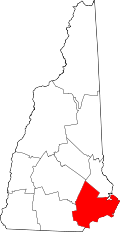Scamman Farm | |
 Scamman Farm in October 2019 | |
| Location | 69 Portsmouth Ave., Stratham, New Hampshire |
|---|---|
| Coordinates | 43°0′33″N70°55′7″W / 43.00917°N 70.91861°W |
| Built | c.1750 |
| NRHP reference No. | 100003597 [1] |
| Added to NRHP | April 4, 2019 |
Scamman Farm is a historic farmstead at Portsmouth Avenue in Stratham, New Hampshire. The farm was established by members of the Scamman family in the 1660s, and includes a barn dating to the mid-18th century, believed to be one of the oldest in the state, and a Greek Revival farmhouse dating to 1836. The property, now a subset of the family's original holdings, was listed on the National Register of Historic Places in 2019. [2]
A fire that began shortly before 11 p.m. on May 10, 2021, burned down one barn on the property and killed an estimated 300 chickens. [3] [4] Through the efforts of firefighters, the mid-18th century barn suffered only minor damage. [5] Days later, the family stated that they would rebuild the barn that burned down. [6]
The similarly named Scammon Farm Historic District, also located in Stratham and owned by a different branch of the family, was added to the National Register of Historic Places in 2023. [7]


